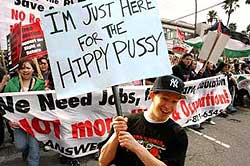Here’s an excerpt from Harvard financial historian Niall Ferguson’s massive Vanity Fair article explaining it all: “Wall Street Lays Another Egg:”
The Lessons of Detroit:In July 2007, I paid a visit to Detroit, because I had the feeling that what was happening there was the shape of things to come in the United States as a whole. In the space of 10 years, house prices in Detroit, which probably possesses the worst housing stock of any American city other than New Orleans, had risen by more than a third—not much compared with the nationwide bubble, but still hard to explain, given the city’s chronically depressed economic state. As I discovered, the explanation lay in fundamental changes in the rules of the housing game.
I arrived at the end of a borrowing spree. For several years agents and brokers selling subprime mortgages had been flooding Detroit with radio, television, and direct-mail advertisements, offering what sounded like attractive deals. In 2006, for example, subprime lenders pumped more than a billion dollars into 22 Detroit Zip Codes.Although the number of defaults in the Greater Detroit region have been high, I suspect the dollars lost are small compared to here in California. See this map again, and change the Affirmative Actioneering in housing from blacks to Latinos?
These were not the old 30-year fixed-rate mortgages invented in the New Deal. On the contrary, a high proportion were adjustable-rate mortgages—in other words, the interest rate could vary according to changes in short-term lending rates. Many were also interest-only mortgages, without amortization (repayment of principal), even when the principal represented 100 percent of the assessed value of the mortgaged property. And most had introductory “teaser” periods, whereby the initial interest payments—usually for the first two years—were kept artificially low, with the cost of the loan backloaded. All of these devices were intended to allow an immediate reduction in the debt-servicing costs of the borrower.
In Detroit only a minority of these loans were going to first-time buyers. They were nearly all refinancing deals, which allowed borrowers to treat their homes as cash machines, converting their existing equity into cash and using the proceeds to pay off credit-card debts, carry out renovations, or buy new consumer durables. However, the combination of declining long-term interest rates and ever more alluring mortgage deals did attract new buyers into the housing market. By 2005, 69 percent of all U.S. householders were homeowners; 10 years earlier it had been 64 percent. About half of that increase could be attributed to the subprime-lending boom.
Significantly, a disproportionate number of subprime borrowers belonged to ethnic minorities. Indeed, I found myself wondering, as I drove around Detroit, if “subprime” was in fact a new financial euphemism for “black.” This was no idle supposition. According to a joint study by, among others, the Massachusetts Affordable Housing Alliance, 55 percent of black and Latino borrowers in Boston who had obtained loans for single-family homes in 2005 had been given subprime mortgages; the figure for white borrowers was just 13 percent. More than three-quarters of black and Latino borrowers from Washington Mutual were classed as subprime, whereas only 17 percent of white borrowers were. According to a report in The Wall Street Journal, minority ownership increased by 3.1 million between 2002 and 2007.
Here, surely, was the zenith of the property-owning democracy. It was an achievement that the Bush administration was proud of. “We want everybody in America to own their own home,” President George W. Bush had said in October 2002. Having challenged lenders to create 5.5 million new minority homeowners by the end of the decade, Bush signed the American Dream Downpayment Act in 2003, a measure designed to subsidize first-time house purchases in low-income groups. Between 2000 and 2006, the share of undocumented subprime contracts rose from 17 to 44 percent. Fannie Mae and Freddie Mac also came under pressure from the Department of Housing and Urban Development to support the subprime market. As Bush put it in December 2003, “It is in our national interest that more people own their own home.” Few people dissented.
As a business model, subprime lending worked beautifully—as long, that is, as interest rates stayed low, people kept their jobs, and real-estate prices continued to rise. Such conditions could not be relied upon to last, however, least of all in a city like Detroit. But that did not worry the subprime lenders.
The other item I would add is the effects of political correctness and discrimination lawsuits on financial institution’s ability to perform reality checks on their own actions. Nobody can send a memo to their colleagues saying “We lent a billion dollars to Detroit?” without being in severe danger of it turning up in the discovery of a "redlining" discrimination case.
Steve Sailer was right; it was a “diversity recession”.











No comments:
Post a Comment